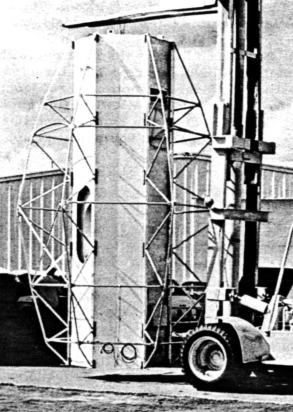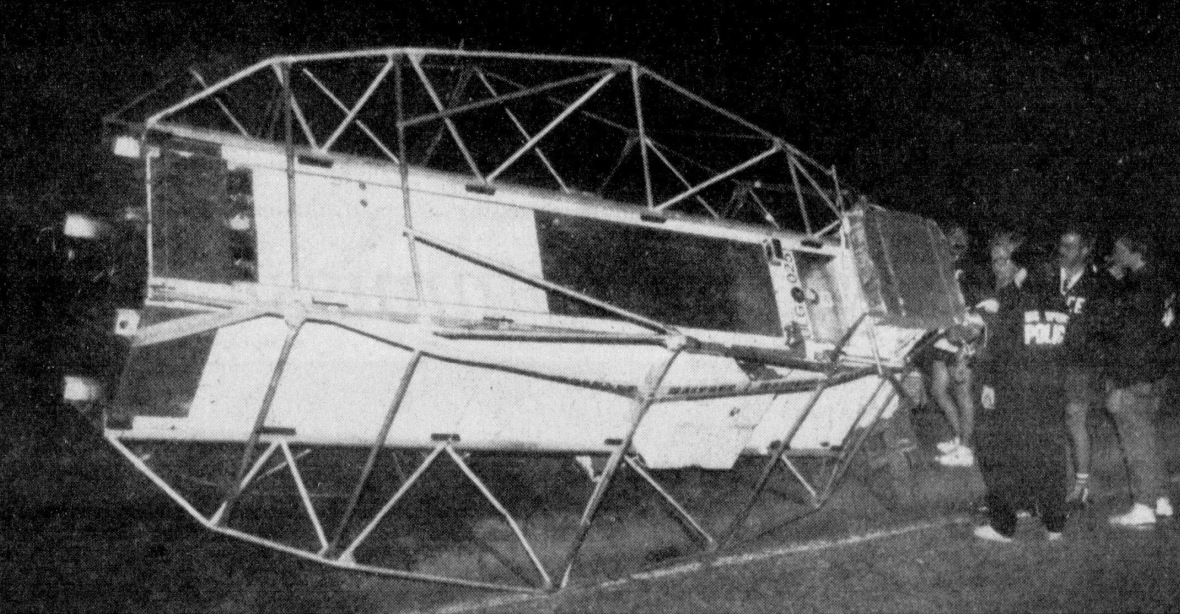Purpose of the flight and payload description
To complement the spectroscopic observations of the sun with high spectral resolution done at the Jungfraujoch International Scientific Station in the Swiss Alps, the Institute of Astrophysics of the University of Liege, from Belgium developed a balloon-borne instrument to observe in all spectral regions not accessible from the ground.
The instrument was composed by a 40-cm aperture Ritchey-Chretien telescope, associated with an Ebert-Fastie-type grating spectrometer of 2.5 meters of focal length. A gimbaled plane mirror directed the solar radiation within the telescope. A solar image of 56 mm diameter was produced in the focal plane of the telescope and its central part was then transferred and focussed onto the entrance slit of the spectrometer by two mirrors. The main mirror of the instrument was spherically shaped to a radius of curvature of 5 meters. Two different gratings were available for covering the 1.5 to 15 microns region. The working order selection was obtained with a set of interference filters mounted on a filter-wheel. All mirrors and mounts were made from light aluminium alloy, kanigen-coated and the optical surfaces were aluminized.
During development was decided to adopt a double-pass configuration, instead os a single one. This allowed to reduce the level of diffused light at the exit slit, to remove spurious grating defects and also to provide an instrumental profile free of secondary "aperture-diffraction maxima". For the 1.5 to 3.0 microns region, the incoming radiation was focussed onto a lead sulfide cell, cooled down to -70°C by thermoelectrical effect; a second PbS detector located near and parallel to the intermediate slit allowed to record simultaneously the spectrum in single pass.
During the scanning, the signals detected by the cells were synchroneously amplified and stored in an on-board magnetic tape recorder as well transmitted to the ground by telemetry for real-time monitoring and optimisation of the equipment by telecommand. A tungsten lamp, which could be placed temporarily in the optical path, was used for in-flight realignment of the spectrometer; it also allowed to determine spectroscopically, the amount of water vapor inside the instrument.
The instrument was mounted inside a 4.75 meter high balloon gondola which contained the optics and all components. The gondola, as well as the telescope and spectrometer frames were made out of aluminium honeycomb. The pointing process was acomplished in two steps. A first coarse pointing using silicon solar sensors which controled an inertial wheel on top of the gondola to direct the aperture of the instrument towards the sun, then the fine pointing was completed moving the main mirror which was mounted in a two-axis gimbaled system, and controlled by torque motors servo-controlled by two pairs of fine solar sensors. The total weight of the balloon equipment was approximately 1100 Kgs.
The program was active from 1969 until 1993, performing 27 balloon flights.
Details of the balloon flight
Balloon launched on: 8/29/1990 at 15:59 utc
Launch site: Columbia Scientific Balloon Facility, Palestine, Texas, US
Balloon launched by: National Scientific Balloon Facility (NSBF)
Balloon manufacturer/size/composition: Zero Pressure Balloon N29-8/8/8T-28.40
Balloon serial number: 428.40-2-123
Flight identification number: 1494P
End of flight (L for landing time, W for last contact, otherwise termination time): 8/30/1990 at 1:08 utc
Balloon flight duration (F: time at float only, otherwise total flight time in d:days / h:hours or m:minutes - ): F 4 h 27 m
Landing site: Inside Big Spring, Texas, US
This flight (ULG-25) was the twenty fifth mission of the program. The balloon was launched by dynamic method on August 29, 1990 at 15:59 utc from the National Scientific Balloon Facility (NSBF) in Palestine, Texas. After a nominal ascent the balloon reached float altitude and started to move toward west carried by prevailing winds. About 8 hours later, the scientific instrument completed its mission and was ready to end its flight as planned in a desert area west of Big Springs, Texas. The termination team was onboard a chase plane that departed that afternoon from the Palestine base. They were cruising about 24,000 feet (8,000 meters) flying west toward the sun when finally they spotted the balloon at 110,000 feet. It was about one half hour from the schedule to terminate the balloon flight and the plane was flying directly toward the balloon when all the sudden the balloon burst. The parachute automatically opened with the payload hanging under it descending very quickly to the ground. Through the telemetry system it was confirmed that the balloon flight was terminated, the person in charge of the termination (an electronics technician) was asked if he had transmitted the flight termination command but he responded that he had not transmitted any commands. It was evident that the balloon failed. A few minutes later, based on the position where the balloon had failed they determined the descent vector of the parachute. That's when they realized that the payload would land in the middle of of the city of Big Springs, Texas.
At once, they contacted by radio the local police chief and told him that in approximately 30 minutes he would have a 1500 pound scientific payload landing somewhere in his town, but they could not tell him exactly where. They give him some indications on where to look to see the parachute so that he could watch it descend. The balloon envelope was the first to hit the ground about 20 minutes after the balloon failure occurred outside the city in the desert. Meanwhile, the chase plane circled the parachute as it was dropping to the ground and contemplated how the payload landed about 45 minutes after the balloon failed in a small park near the middle of the city. The park was one block square and there were no other empty lots within six blocks in every direction from that park. The payload landed and tipped over as it was a very tall mass (about 23 feet tall). The parachute ended up falling over power lines which eliminated the power to about 1/4 of the town. The top of the parachute landed on the roof of a one level apartment complex with only minor damage to the roof.
The NSBF team landed the airplane at the local airport and was intercepted by a Police car that drove them to the payload impact location. It was a very lucky situation that the payload landed in the middle of the city without hitting a single structure. The other part of the NSBF rescue crew which was in the recovery truck approaching Big Springs was contacted by the plane team by radio and was directed to the impact location.
About 9 pm sunset occured and the power outage was very noticeable in the area of the town where the payload had impacted. While at the Police Station, the NSBF team learned that the television station in Midland (1.5 hour drive from Big Springs) was aware of the incident and sent a crew to obtain the story and get video coverage. Very quickly they got the recovery crew to the impact location, loaded the payload on the recovery trailer and removed the parachute from the roof of the apartment. Meanwhile, the TV crew appeared at the central police station when some of the members of the NSBF were. The Police Chief asked if they would like to do an interview for television or whether he should do the interview. They told him that wanted to minimize all publicity about the incident so the Police Chief made the interview to give the NSBF crew time to complete the recovery operation and leave the town. They left the station using a back door and drove past the station back to the impact location, collected the crew with the payload on the truck trailer and the parachute packed away, and drove out of town at about 11:00 pm.
The crew went to the next town, about 40 miles away and checked into motel rooms for the night. They parked the recovery truck and trailer in the back of the motel where it could not be seen. The next morning the pilot and part of the crew in the airplane drove back to Big Springs, where arrangements were made to pay for all the damage with the electrical power company and the City of Big Springs. After that, the crew boarded the plane and returned to Palestine, Texas. The only publicity of the incident were a couple of notes in the local newspaper including the photos shown at right, see references below.
This account was told to StratoCat by one of the persons involved in the incident.
External references
- LIEGE Univ. Experiment landing in Big Springs 1/2 News clipping from Big Spring Herald, August 30, 1990
- LIEGE Univ. Experiment landing in Big Springs 2/2 News clipping from Big Spring Herald, August 30, 1990
- NASA Balloon Flights (1989-1998) in NASA Historical Data Book, Vol. VII: NASA Launch Systems, Space Transportation, Human Spaceflight, and Space Science, 1989-1998
9664If you consider this website interesting or useful, you can help me to keep it up and running with a small donation to cover the operational costs. Just the equivalent of the price of a cup of coffee helps a lot.




